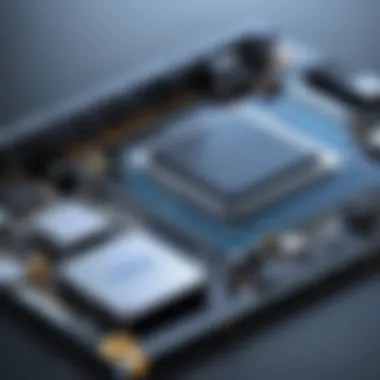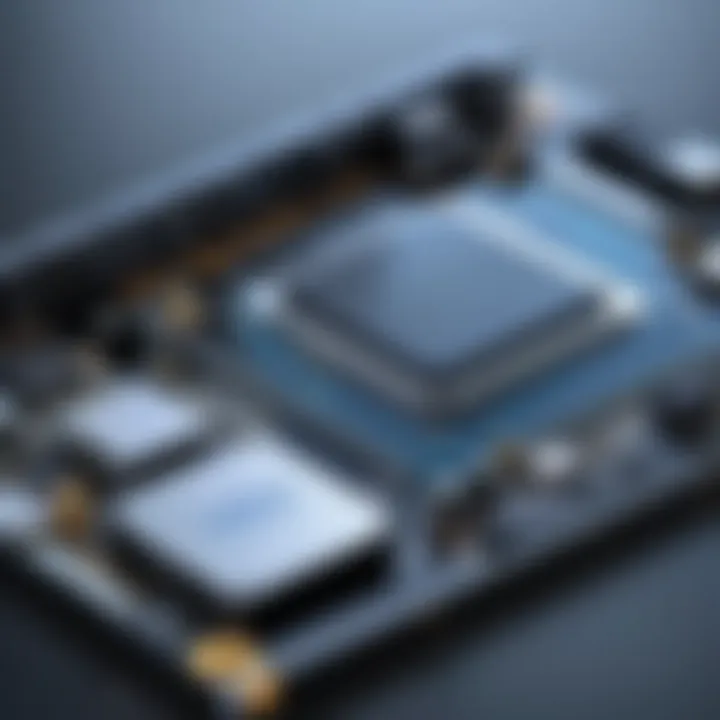Strategies for Enhancing Windows 10 Performance: Combatting Slow Computer Issues


Overview of Enhancing Windows Performance
When delving into the realm of optimizing Windows 10 performance, it is imperative to address the common issue of sluggishness that plagues many computer systems.
The objective of this comprehensive guide is to equip readers with the necessary strategies and insights required to combat slow computer performance effectively. By meticulously exploring the contributing factors that lead to system sluggishness, individuals can elevate their computing experience to new heights through effective troubleshooting methods, meticulous system maintenance practices, and strategic software adjustments.
Strategies for Enhancing Windows Performance
Effective strategies for optimizing Windows 10 performance on sluggish computers can significantly elevate the user experience. Unearthing important troubleshooting tips, system maintenance practices, and software adjustment techniques forms the cornerstone of this guide. By meticulously examining each facet, readers can embark on a journey towards an enhanced and streamlined computing encounter. 🚀
Understanding Computer Slowdowns
As we delve into the realm of Understanding Computer Slowdowns within the context of optimizing Windows 10 performance, it becomes abundantly clear that this topic serves as the cornerstone of our journey towards addressing slow computer performance issues. The significance of grasping the intricacies of computer slowdowns lies in its ability to equip readers with the necessary knowledge to troubleshoot effectively, maintain system efficiency, and make strategic software adjustments that can vastly enhance the overall computing experience.
Common Causes of Slow Performance
Inadequate System Resources
Delving into the first common cause of slow performance, Inadequate System Resources, sheds light on a critical aspect influencing system speed. The crux of the matter revolves around the limited availability of essential resources such as RAM, CPU power, and storage space. This inherent lack of resources can significantly impede system functionality, resulting in sluggish performance, frequent delays, and overall inefficiency. Understanding the key characteristic of Inadequate System Resources lies in recognizing its direct link to system responsiveness and multitasking capabilities. While it may seem like a cost-effective choice on the surface, opting for inadequate system resources can ultimately hinder system performance and user productivity, making it a suboptimal choice when aiming for optimal computing efficiency.
Software Bloatware
Moving on to another prevalent issue, Software Bloatware, we encounter a common culprit responsible for system sluggishness. Software bloatware refers to unnecessary, resource-intensive programs that consume system resources without providing commensurate benefits to the user. The key characteristic of bloatware lies in its tendency to slow down system operations, increase boot times, and clutter the system with redundant applications. While bloatware may come pre-installed or inadvertently downloaded, it poses a significant disadvantage to system performance by monopolizing system resources and impeding overall functionality. Eliminating or avoiding software bloatware emerges as a prudent choice when aiming to enhance system speed and efficiency.
Outdated Hardware Drivers
Transitioning to the realm of outdated hardware drivers, we confront yet another factor contributing to slow performance issues. Outdated hardware drivers, which control the interaction between hardware components and the operating system, play a crucial role in system stability and performance optimization. The key characteristic of outdated hardware drivers resides in their potential to introduce compatibility issues, security vulnerabilities, and performance inconsistencies within the system. While overlooking driver updates might appear convenient in the short term, the long-term consequences span from system instability to compromised functionality, making timely driver updates imperative in ensuring optimal system performance.
Malware and Viruses
Lastly, the treacherous world of malware and viruses emerges as a formidable adversary in the realm of system speed. These malicious entities can infiltrate systems through various means, compromising data integrity, system stability, and overall performance. The key characteristic of malware and viruses lies in their insidious nature, often remaining undetected while wreaking havoc on system resources and functionality. Succumbing to malware or viruses poses a grave disadvantage in the context of system optimization, as they can slow down processes, corrupt files, and jeopardize sensitive information. Implementing robust security measures and maintaining up-to-date antivirus software proves essential in safeguarding system integrity and preserving optimal performance.
Impact of Windows on System Speed
Resource Consumption
Turning our attention to the impact of Windows 10 on system speed, we confront the vital aspect of resource consumption within the operating system. Resource consumption alludes to the utilization of system resources such as CPU, RAM, and disk space by various processes and applications running on the system. The key characteristic of resource consumption lies in its direct correlation with system performance and responsiveness. While Windows 10 offers a feature-rich computing environment, excessive resource consumption can lead to performance bottlenecks, system lag, and overall sluggishness. Balancing resource allocation and monitoring resource-intensive processes emerge as pivotal strategies in optimizing system speed and efficiency.
Background Processes
A significant contributor to system speed within Windows 10 is the realm of background processes. Background processes represent tasks and operations that occur behind the scenes, often consuming system resources without the user's explicit knowledge. The key characteristic of background processes lies in their ability to impact system performance discreetly. While some background processes are essential for system functionality, excessive or unnecessary processes can hog system resources, leading to decreased performance and responsiveness. Maintaining vigilance over background processes, prioritizing essential tasks, and minimizing resource-heavy operations constitute prudent practices in enhancing system speed within the Windows 10 environment.


System Updates
Furthermore, the role of system updates in system speed cannot be overlooked within the Windows 10 ecosystem. System updates encompass critical patches, feature enhancements, and security fixes provided by Microsoft to optimize system performance and reliability. The key characteristic of system updates lies in their ability to address known issues, improve system functionality, and enhance overall user experience. While system updates are designed to bolster system security and performance, untimely or incomplete updates can inadvertently disrupt system operations and impede speed. Regularly installing updates, configuring update settings, and ensuring system compatibility paves the way for a streamlined, efficient computing experience within Windows 10.
Identifying Symptoms of Poor Performance
Slow Boot Times
Among the key symptoms of poor performance, slow boot times stand out as a tangible indicator of system inefficiency. Slow boot times refer to extended periods required for the system to initialize and become operational. The key characteristic of slow boot times lies in their capacity to delay user access to the system, hamper productivity, and indicate underlying performance issues. While occasional delays may be inevitable, persistent slow boot times signify deeper-rooted problems such as software conflicts, insufficient resources, or storage issues, warranting prompt investigation and corrective action to restore optimal system performance.
Unresponsive Applications
In the realm of identifying poor performance symptoms, unresponsive applications present a frustrating predicament for users seeking seamless functionality. Unresponsive applications denote instances where programs fail to respond to user input promptly or exhibit sluggish behavior during operation. The key characteristic of unresponsive applications lies in their disruption of user workflow, leading to productivity loss and system frustration. Root causes of unresponsive applications may stem from insufficient system resources, software conflicts, or lingering background processes, necessitating troubleshooting measures, performance optimizations, and resource management techniques to rectify application responsiveness issues.
System Freezing
Lastly, system freezing emerges as a severe symptom of poor performance, signifying critical operational breakdowns within the system. System freezing manifests as an abrupt cessation of system functions, rendering the system unresponsive to user commands. The key characteristic of system freezing lies in its debilitating impact on user productivity, data integrity, and system stability. While occasional freezes may occur due to system strain or software glitches, recurrent or prolonged system freezing indicates underlying hardware failures, software instabilities, or malware infections, demanding immediate attention, diagnostic actions, and remedial interventions to restore system operability and performance.
Optimization Techniques
Optimization Techniques play a crucial role in enhancing the performance of Windows 10 systems struggling with slow computer speeds. By actively engaging in optimization methods, users can effectively address underlying issues contributing to sluggishness. Implementing these techniques ensures smoother system operation, improved response times, and overall enhanced user experience. Users should consider factors such as adequate system resources, efficient software management, and regular system maintenance when focusing on optimization.
Performance Monitoring and Diagnosis
Task Manager Analysis
Task Manager Analysis serves as a fundamental tool in evaluating system performance and resource utilization. This feature provides real-time insights into running processes, CPU usage, memory consumption, and network activity. By utilizing Task Manager Analysis, users can pinpoint resource-intensive applications, identify bottlenecks, and optimize system efficiency. Its user-friendly interface and detailed performance metrics make it an invaluable asset for monitoring and diagnosing system performance.
Resource Monitor Utilization
Resource Monitor Utilization plays a vital role in comprehensively analyzing hardware and software performance. This tool offers detailed information on CPU, disk, memory, and network usage, allowing users to identify process-specific resource consumption. By leveraging Resource Monitor, users can optimize system resources, troubleshoot performance issues, and ensure efficient operation. Its customizable features and intuitive design make it a favored choice for in-depth system monitoring and performance tuning.
System Health Checks
System Health Checks are essential for assessing the overall well-being of a computer system. These checks involve evaluating hardware components, system stability, and resource allocation. By conducting regular system health checks, users can proactively identify potential issues, prevent system failures, and maintain optimal performance. Although system health checks require time and effort, their benefits in ensuring system reliability and longevity are undeniable.
System Cleanup and Maintenance
Disk Cleanup
Disk Cleanup plays a critical role in optimizing storage space and enhancing system performance. This utility removes unnecessary files, temporary data, and system cache, reducing clutter and freeing up disk space. Through consistent disk cleanup, users can improve system responsiveness, prevent storage issues, and streamline system operations. Its simplicity and effectiveness make it a popular choice for routine system maintenance and performance optimization.


Defragmentation
Defragmentation is a key process for organizing data on a hard drive to improve access times and system performance. This utility rearranges fragmented files, consolidates free space, and enhances data retrieval speeds. By periodically defragmenting the hard drive, users can optimize file access, enhance system stability, and prolong hardware lifespan. Despite potential drawbacks such as increased disk workload, the benefits of defragmentation in boosting system performance are significant.
Temporary Files Removal
Temporary Files Removal is essential for clearing temporary data generated by applications and system processes. These files, if left unchecked, can accumulate over time, occupying valuable storage space and slowing down system operations. By regularly removing temporary files, users can prevent storage bloat, reduce system clutter, and optimize overall system performance. The simplicity and immediate impact of this maintenance task make it an integral part of system cleanup and optimization.
Software Optimization Strategies
Startup Program Management
Startup Program Management enables users to control the programs that launch automatically with system startup. By managing startup programs, users can reduce system boot times, optimize memory usage, and prioritize essential applications. This strategy allows users to improve system responsiveness, streamline resource allocation, and tailor system performance to their specific needs. Despite potential conflicts with software compatibility, startup program management offers significant benefits in optimizing system startup and resource utilization.
System Configuration Tweaks
System Configuration Tweaks involve customizing system settings to enhance performance and stability. Users can adjust parameters related to startup processes, visual effects, and system preferences to optimize system resources. By fine-tuning system configurations, users can improve overall system responsiveness, minimize resource wastage, and maximize user productivity. While system configuration tweaks may require technical expertise, their positive impact on system performance justifies the effort and attention invested.
Software Updates
Software Updates are crucial for ensuring system security, performance enhancements, and bug fixes. By regularly updating software applications and system components, users can safeguard their systems from vulnerabilities, optimize program functionality, and maximize compatibility with the latest technologies. Despite potential interruptions in workflow and compatibility issues, software updates provide essential features, improvements, and security patches vital for system optimization and longevity.
Enhancing System Performance
Enhancing system performance in the context of optimizing Windows 10 revolves around maximizing the efficiency and speed of computer operations. By focusing on hardware upgrades, system settings optimization, and regular maintenance practices, users can significantly enhance their computing experience. This section will delve into key strategies for boosting system performance and overcoming sluggishness.
Hardware Upgrades and Enhancements
When aiming to enhance system performance, considering hardware upgrades is essential. By investing in components like RAM expansion, SSD installation, and graphics card updates, users can experience improved speed and responsiveness in their computing tasks.
RAM Expansion
RAM expansion plays a crucial role in enhancing system performance by providing additional memory space for running applications and processes. With increased RAM capacity, computers can handle more tasks simultaneously, leading to smoother multitasking and faster response times. The key characteristic of RAM expansion lies in its ability to reduce system lag and improve overall efficiency. While this upgrade is popular for its efficiency gains, users must consider compatibility and installation complexities as potential drawbacks.
SSD Installation
Installing a solid-state drive (SSD) is another significant enhancement for system performance. SSDs offer faster data access speeds and quicker boot times compared to traditional hard disk drives. The key characteristic of SSD installation is the drastic improvement in system responsiveness and file access times. While SSDs boost overall system speed, their higher cost per storage might be considered a disadvantage.
Graphics Card Updates
Updating the graphics card can contribute to enhanced system performance, especially in tasks requiring high visual processing. By installing a newer graphics card, users can enjoy smoother gameplay, faster rendering of graphics, and an overall better visual experience. The key characteristic of graphics card updates is the improved display quality and graphics performance. However, users should be aware of compatibility issues and the need for proper driver updates for optimal functionality.


System Settings Optimization
Optimizing system settings is paramount in achieving peak performance from a Windows 10 computer. Adjusting power settings, customizing visual effects, and configuring virtual memory can significantly impact system speed and efficiency.
Power Settings Adjustment
Fine-tuning power settings plays a crucial role in optimizing system performance. By adjusting power plans to balance energy savings and performance, users can tailor their computer's power usage to meet specific needs. The key characteristic of power settings adjustment is the ability to maximize battery life or processing power based on user preferences. However, incorrect settings may lead to suboptimal performance or reduced battery efficiency.
Visual Effects Customization
Customizing visual effects allows users to personalize their computing experience while potentially improving system performance. By adjusting visual settings such as animations, shadow effects, and window transitions, users can enhance aesthetics without compromising speed. The key characteristic of visual effects customization lies in its impact on system responsiveness and graphical presentation. Yet, excessive customization may burden system resources and hinder performance.
Virtual Memory Configurations
Configuring virtual memory settings is crucial for managing system resources effectively. By adjusting virtual memory allocation, users can prevent memory-related performance issues and ensure smooth operation of applications. The key characteristic of virtual memory configurations is its role in providing additional memory space when physical RAM is depleted. However, improper settings may lead to disk thrashing and reduced system performance.
Regular System Maintenance Practices
Engaging in regular system maintenance practices is vital for preserving system health and performance. By staying up to date with software updates, ensuring proper driver installations, and implementing data backup procedures, users can maintain a high level of system efficiency and reliability.
Software Updates
Regular software updates are essential for addressing security vulnerabilities, improving functionality, and enhancing compatibility with Windows 10. By installing the latest software patches and updates, users can safeguard their systems against cyber threats and ensure optimal performance. The key characteristic of software updates is their ability to deliver new features and performance enhancements. However, delayed or inconsistent updates may expose systems to potential risks and performance issues.
Driver Installations
Proper driver installations are critical for hardware components to function smoothly with Windows 10. By updating drivers for devices such as graphics cards, network adapters, and peripherals, users can resolve compatibility issues and improve system stability. The key characteristic of driver installations is their role in facilitating communication between hardware components and the operating system. Nonetheless, incompatible or missing drivers can lead to hardware malfunctions and diminished performance.
Data Backup Procedures
Implementing effective data backup procedures is indispensable for safeguarding essential files and ensuring quick recovery in case of system failures. By regularly backing up personal data to external storage or cloud services, users can prevent data loss and minimize downtime. The key characteristic of data backup procedures is their ability to restore systems to a previous state following data corruption or system malfunctions. Despite the advantages of data backup, inadequate backup frequency or storage capacity may compromise recovery efforts.
Final Thoughts and Recommendations
In this culminating section of our comprehensive guide on optimizing Windows 10 and addressing slow computer performance issues, it is crucial to emphasize the significance of final thoughts and recommendations. As readers navigate through the intricacies of troubleshooting methods, system maintenance practices, and software adjustments, arriving at a conclusive set of guidance becomes paramount. These final thoughts serve as a compass, directing users towards sustainable improvements in their computing experience. By carefully distilling the essence of the previous sections, this segment encapsulates distilled insights tailored to aid readers in their pursuit of streamlined system efficiency and enhanced productivity.
Consistent Monitoring and Adaptation
System Performance Tracking
Delving into the realm of system performance tracking within the context of optimizing Windows 10, we encounter a robust mechanism for gauging the effectiveness of implemented strategies. Tracking performance metrics provides users with a quantitative lens through which they can measure the impact of their optimization efforts. Key characteristics of system performance tracking include real-time data analysis, trend identification, and proactive issue resolution. This feature serves as a foundational pillar for adapting techniques based on empirical evidence, steering users towards tangible performance enhancements while fostering a proactive approach to system optimization.
Adopting Best Practices
Embarking on the journey of adopting best practices in system optimization offers users a roadmap towards sustainable and efficient computing. By encapsulating industry-recognized methodologies and techniques, users can leverage proven strategies to maximize system performance. The key characteristic of adopting best practices lies in its inherent scalability and adaptability to diverse hardware configurations and user requirements. This approach ensures a holistic optimization framework that aligns with the unique needs of individual systems, culminating in a tailored and effective system enhancement strategy.
Seeking Professional Assistance
For users seeking to navigate the complexities of system optimization with expert guidance, the option of professional assistance holds significant merit. Leveraging the specialized knowledge and experience of professionals enables users to streamline the optimization process, mitigate risks, and achieve optimal results efficiently. The key characteristic of seeking professional assistance is the personalized guidance and tailored solutions offered by experts in the field. While this avenue may incur additional costs, the advantages of accelerated optimization processes, in-depth system analysis, and expert recommendations outweigh the potential drawbacks for users prioritizing efficient and reliable optimization outcomes.







